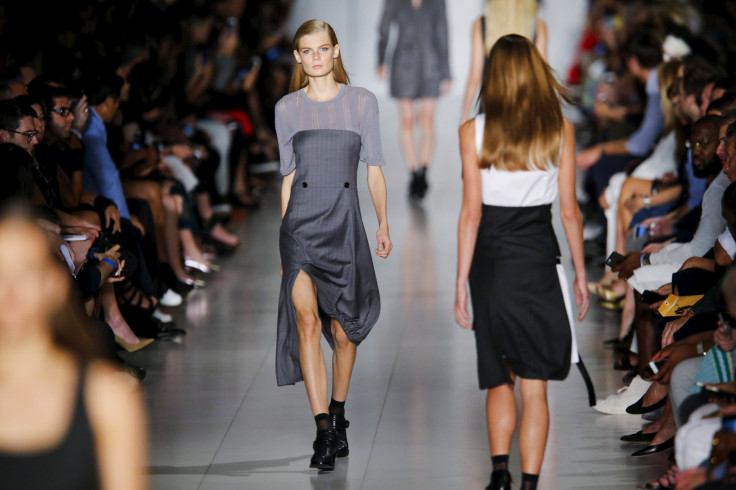NYFW 2016: At New York Fashion Week, How France’s Bans On Thin Models Could Extend To US

The models strutting down the catwalk Thursday during the official kickoff of New York Fashion Week have many things in common: beauty, style and a clear sense of rhythm that became apparent with the pulsating music accompanying their sashaying hips. But there’s also one other, more obvious shared attribute: a near skeletal physique that has become the gold standard in the fashion industry.
But that could all change with the recent implementation of a new French law banning too-thin models from the runway. This year's New York Fashion Week is the first since the bill passed in December, sending ripples through an industry that has a de facto capital in Paris. The business has long been criticized for glamorizing unhealthy images of beauty, leading fashion and retail experts to view France's new law as a positive regulation and insist it will ultimately alter how models look on runways across the United States.
As hundreds of people filed into the historic Skylight at Moynihan Station in midtown Manhattan Thursday morning, there was an excited, almost electric buzz in the air. Thursday marked the official kickoff of New York Fashion Week, and BCBGMAXAZRIA (sometimes referred to as BCBG Max Azria) was the second show of the day. Women dressed in stylish furs and wide-brimmed hats sat next to men in smartly fitting suits. As the lights dimmed and music began to loudly pulsate, thin and beautiful models started to strut down the catwalk. For this season's show, the models had a uniform look: tall and slender.
"I definitely think France's new law will trickle down and affect runway shows here," said Ashley Johnson at the Skylight. The 28-year-old works for designer line BCBG and has attended NYFW six times. "I think we'll gradually start to get more normal-figured women on the runway," she said.

France joined a growing list of countries that includes Italy, Spain and Israel when it adopted legislation banning super-thin models from the runways. Under the law, models are required to present a doctor’s certificate stating that their health is “compatible with the practice of their profession,” and employers who break the law could face up to six months in jail and an $81,000 fine.
While a previous version of the legislation proposed a minimum body mass index, the final draft that was approved allows doctors to make the decision whether a model is too thin by considering his or her weight, age and body shape. Additionally, the new law stipulates that advertisements featuring models whose body shapes have been altered be labeled “photograph edited.” The law aims to combat the widespread, eating disorder epidemic that plagues the country: In France, anorexia affects 30,000 to 40,000 people, 90 percent of whom are women.
The legislation initially ignited backlash from many modeling agencies in France. Isabelle Saint-Felix, general secretary of Synam, France’s union of model agencies, criticized the law, arguing that, “the power is in the hands of designers, photographers and editors … modeling agencies respond to the demand of advertisers, designers and photographers.”
However, the law was hailed by health advocates, and an editorial was published in the American Journal of Public Health urging the U.S. government to adopt similar legislation. While the United States has not implemented its own similar regulations, France’s bill could have a trickle-down effect and impact runway shows in cities throughout the states, from New York to Los Angeles, fashion industry veterans said.
“A lot of designs that show in Paris show in New York as well, so the designers will be using similar characteristics in their line … they won’t change it from city to city,” said Michael Londrigan, the dean of Academic Affairs at LIM College in New York City and a fashion industry veteran who has worked in the industry for 30 years, including at New York Fashion Week. “While there’s nothing in the U.S. that says that they [underweight models] can’t walk, if they are saying you can’t walk in Paris, if I were a designer, why would I allow that similar body type to walk in New York?”

Marshal Cohen, the chief industry analyst of the market research firm NPD Group, has followed retail trends for over 30 years. As the former head of leading fashion and apparel manufacturers and major retailers, he said while he doesn't expect to see over-arching effects of France’s law in this month’s New York Fashion Week, he anticipates that the law will eventually reach the U.S. and impact runway shows in the states.
“I think it’s too soon for it to impact this particular fashion week,” said Cohen. “I think you will hear about it, but you won’t see it. The next fashion week is when you will begin to see it, when the models will have gained a little bit of weight and the brands will try and make it part of the equation … the people that are in charge of running the shows will catch on that this is the responsible thing to do and tag on to it. New York and Los Angeles want to be just as important as Paris, so if they do it, we want to do it.”
France’s legislation comes at a time when the landscape of the fashion industry, specifically midpriced retailers, is slowly shifting. An increasing number of designers are starting to acknowledge that their consumers don’t necessarily look like the models that glide down the runway. Lane Bryant, for example, unveiled a new campaign dubbed PlusIsEqual last fall that featured plus-sized models and strived to give women of all sizes equal representation in the media.

“What we're seeing is that the plus-size market is using more plus-sized models,” said Londrigan, the dean at LIM. “In the past, you would never see a model that represented who their actual customer was.”
Katherine Schofield, a senior at the University of Iowa, is headed to Paris this summer to work hands-on with a fashion designer for an internship. The 22-year-old communication studies major hopes to one day to work in public relations for a designer, and has noticed that marketing more toward the everyday consumer is a trend in the industry.
“You need to market to consumers, and I think they’re [the designers] realizing that and you need to look at the average person who will be buying your products,” said Schofield. “I know that Diane Von Furstenberg, she’s definitely leaning towards looking more to the consumer and who the typical consumer is that will be buying these products … they [designers] are trying to look at the big picture of the fashion industry and not a narrow-minded view of the industry."

Still, many experts in the fashion industry, including Londrigan and Cohen, have remained wary that high-couture fashion and runway looks will tailor more toward the everyday consumer, despite France’s legislation.
“The fashion shows themselves are huge marketing tools to create buzz around the products, and what happens on the runway does not always transfer to what happens online and in the stores,” said Londrigan. “I think the couture designers will continue to design more toward ideal body type ... In reality, you have designers that can do whatever they want and customers will still want to buy their product.”
However, the law is still pushing the industry forward in a progressive direction. Sharlene Xu, a senior at the University of Kansas who works part-time modeling for runway shows, has walked in St. Louis Fashion Week and Kansas City Fashion Week, and views France’s law as a step in the right direction.
“Nowadays people view what they think they are supposed to look like through these models, and I think it’s important for this law to be made … it’s going in the right direction,” said Xu, 22. “I think in Paris there will be a test run. I do hope that a similar law is passed in the United States, and other places as well. The standards should be universal.”

Longdrian also said the law is a good thing for the industry as a whole, even though he does not anticipate similar legislation to occur in the U.S. in the near future.
“I think the law will have a positive impact from a human perspective and that the body types you’ll start seeing coming forward will hopefully be closely mirrored to who the consumer is. It’s a start," said Longdrian. "There will be additional things coming out of this, more positive role models for younger women … I think there should be enough public pressure on the designers and the companies to makes sure the models they are using represent the consumer, from a holistic standpoint, are healthy.”
© Copyright IBTimes 2024. All rights reserved.






















